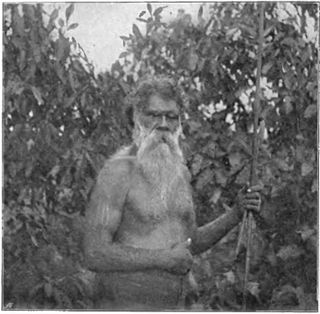This page is based on this
Wikipedia article Text is available under the
CC BY-SA 4.0 license; additional terms may apply.
Images, videos and audio are available under their respective licenses.
The Amarak, also written Ngamarak, and now more commonly referred to as the Amurdak, are an indigenous Australian people of the Cobourg Peninsula in the Northern Territory.

The Thaua/Thawa, also spelt and also called Yuin-Djuin, were an Indigenous Australian tribe living around the Twofold Bay area of the South Coast of New South Wales.
The Walgalu were an indigenous Australian people of New South Wales. The Ngambri may belong to the Walgalu grouping, but are treated under a separate heading
The Wandandian were an indigenous Australian people of the South Coast of New South Wales with connections to the Yuin and Tharawal nations.

The Kangulu, also written Gangulu, is an aboriginal tribe from the Mount Morgan area in Queensland, Australia.

The Ngarigo are an indigenous Australian people of southeast New South Wales, whose lands also extended around the present border with Victoria.

The Krauatungalung were an indigenous Australian tribe of East Gippsland, in Victoria. According to Norman Tindale, their inclusion as one of the 5 tribes constituting the Gunai is artificial. Their descendants now identify themselves with the GunaiKurnai nation.
The Djilamatang were thought to be a distinct Indigenous Australian people of the state of Victoria, Australia. This has recently been questioned by Ian Clark.
The Dhudhuroa people were an Indigenous Australian people of North-eastern Victoria, in the state of Victoria, Australia.
The Brataualung were an Indigenous Australian people, one of the five tribes of Gippsland, in the state of Victoria, Australia, and part of a wider regional grouping known as the Kurnai.
The Tatungalung were an indigenous Australian tribe of the state of Victoria. They are often, together with the Bratauolung, Braiakaulung, Brabiralung and Krauatungalung classified as belonging to one nation, the Gunai/Kurnai, though this typology has been thought, by Norman Tindale for one, to be an artificial construct.
The Jaitmatang, also spelled Yaithmathang, were an indigenous Australian people of the State of Victoria.
The Wiri were an indigenous Australian tribe of the state of Queensland.
The Walbanga were an indigenous Australian people of New South Wales, part of what are now called the Yuin people.
The Kunandaburi or Karendala (Garandala) were an indigenous Australian people of the state of Queensland.
The Madjandji, also known as the Majañji, are an indigenous Australian people in the area south of Cairns in the state of Queensland.
The Guŋgañji, also transcribed Gungganyji or written as Kongkandji, are an indigenous Australian people of the state of Queensland.
The Marulta were an indigenous Australian people of the state of Queensland.
The Yindjilandji are an indigenous Australian people of the Northern Territory.








